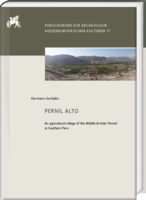|
|
more titles of the subject:
Download:
As of yet, little is known about the emergence of agriculture in the Central Andes. The results of the investigations of the Middle Archaic settlement of Pernil Alto (3800-3000 BC) presented in this volume now provide important insights for a better understanding of this development.
The site of Pernil Alto is located in the foothills of the Andes in Southern Peru. Extensive excavations were carried out here by the German Archaeological Institute. Within the scope of this research, the economic development, form of mobility and social structure were investigated. For this purpose, the discovered remains (artefacts, dwellings, burials, botanical and faunal remains, and human remains) were analyzed and numerous 14C-analyses and Sr-analyses were carried out. The results were combined in a multi-proxy analysis and evaluated in relation to paleo-environmental findings. The result is a six-phase settlement with intra-site burials. During the first phase (ca. 3800-3300 BC), it was a settlement of foragers that relied on food collection, but already cultivated domesticated plants in an additional low-level food production. From the second phase (ca. 3300 BC) onwards, the settlement had developed into a permanent, structured village in which agriculture constituted the basis of subsistence. This is hitherto one of the oldest documented villages in the Americas where agriculture formed the basis of subsistence. The results of the research conducted at Pernil Alto thus contribute to a better understanding of the formation of slightly later first complex, marine-agricultural societies on Peru‘s central coast. |






